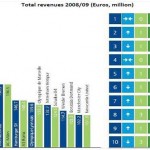KPIs in football – How do they work?
A recent article published in The Guardian was related to KPIs in football. What might all that be about? Measuring performance in football? How do you do that? Well, for starters, it’s all about establishing a set of goals that players must achieve in order to gain financial rewards. Then, it goes on to keeping track of all players and recording their every movement. The article presents the example of the Qatar Football Association’s trying to improve the performance measurement of their players and the advice they give for pursuing this target. They say that the method they are currently using is feasible in all football clubs, and that the results do not fail to appear.
Assessing performance in a football team is crucial for the game and further winnings. It is important to stimulate players by rewarding their performance, but this should be done according to some well-defined criteria. So let us proceed to the presentation of the method currently used by the Qatar Football Association so that we may have a better understanding of the whole process.
First of all, salaries for football players in Qatar are a lot smaller as compared to those in other regions. Therefore, the players have to show a great deal of interest for the improvement of their performance, followed by concrete attempts to hit targets and visual results. In this respect, Valter Di Salvo, director of football and science of the Qatar Football Association and its Aspire Academy, talks about the implementation of performance-related pay in the Qatar Star League. And the rewards system is constructed as it follows:
- 40% of the maximum bonus takes into consideration the total number of appearances a player reaches. This means that every presence and activity in games is recorded. Di Salvo says that whether you are a first-team player, a national team player or play on a regular basis carries a great deal of weight in the final division of bonuses.
- Another 40% is attributed to players’ skill levels, to their commitment to the game and self-improvement as well as to the level of professionalism they show. This share also includes the attendance to training and charity days, and also the fulfillment of media commitments.
- The last 20% are assigned to players’ physical performance. Each player is fitness-tested three times a season and the resulting numbers are then compared to other players.
The article also argues the possibility of KPIs being detrimental to a team’s performance, in the sense that some players may be trying to overshadow their team-mates in a vicious attempt to score points for bonuses. This is indeed a real issue, as the desired result of the whole performance assessment and rewarding process does not focus on this. The purpose of the implementation of the performance-related pay, as Blake Wooster (Business Development Director at Prozone) puts it, is to establish incentives that “reward the individual while recognizing the team”.
To put it in a nutshell, the establishment of key performance indicators is becoming more and more efficient in the development of football teams in Qatar. As in every other area of activity, team sports require a constant assessment of performance as to help them decide which aspects require improvement and which are already giving great results.
For further reading, check out the original article.
References:

Tags: Football performance, KPI, KPI in Practice, Qatar Football Association, Sports performance






